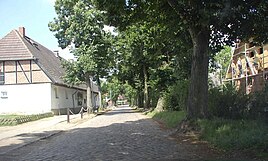Puchow
|
Puchow
community Kuckssee
Coordinates: 53 ° 32 ′ 4 ″ N , 13 ° 4 ′ 9 ″ E
|
||
|---|---|---|
| Height : | 60 m | |
| Area : | 5.65 km² | |
| Residents : | 143 (December 31, 2010) | |
| Population density : | 25 inhabitants / km² | |
| Incorporation : | January 1, 2012 | |
| Postal code : | 17217 | |
| Area code : | 03962 | |
|
Location of Puchow in Mecklenburg-Western Pomerania |
||
|
Village street in Puchow
|
||
Puchow is a district of the municipality of Kuckssee in the Mecklenburg Lake District in Mecklenburg-Western Pomerania (Germany).
geography
The place is located on Wokuhlsee and Zieskensee (also called Ziese). The strong glacier folding of the last Ice Age determines the landscape, which opens wide and relatively flat to the south-east towards the city of Penzlin, while to the north-west the large Carlstein Forest extends to Wrodow . On the road from Penzlin to Lapitz , an Os rises from the Ziese - a natural ridge that represents the remainder of an Ice Age sand dune. It extends to Rahnenfelde and is overgrown with larches and pines. The locals have always referred to this elevation as the robber mountain. Northeast of Ziese and Rahn field lies the nature reserve Kuckssee and Lapitzer lake , which almost seamlessly to the bird sanctuary of Malliner lake connects.
Rahnenfelde is a district of Puchow.
Place name
The name is of Slavic origin, as indicated by the ending -ow, and could be derived from the Old Slavic locator Pucha, meaning "place of Pucha".
Another derivation would be the origin of the old Slavic “puh” or “puhl” for “hollow”.
history
In 1326 the village, a number of individual farms, was first mentioned; a certificate confirms the church.
In a document dated July 18, 1501, Puchow is named as a farming village. The farmers were obliged to serve the knight Berend Maltzan , who was also called "Bad Bernd" . 100 years later the farms belonged to the knights through indebtedness and pledging. At the beginning of the 17th century, the pawns were Hans Angermünde and the pastor Lukas Schröder.
The church burned down around 1650/1659. One of their bells from 1506 is in a belfry in the cemetery. During this time, a Vorwerk Puchow with 64 inhabitants was first mentioned , which was connected to the Klein Lukow manor .
In the 17th and 18th centuries, the property changed frequently (including the von der Hanken family). Ulrich Freiherr von Maltzan acquired Puchow and Rahnenfelde in 1878.
From 1908 to 1945 the estate on which the manor house was built in 1910 was owned by the von Buengner family, who come from Riga.
From 1945 the estate was relocated through the land reform . From 1960 there was an agricultural production cooperative (LPG) in the village with Rahnenfelde . After 1945 to 1990 the manor house was a cultural academy for the Neubrandenburg district .
On January 1, 2012, the municipality of Puchow gave up its independence and merged with Krukow and Lapitz to form the municipality of Kuckssee .
Attractions
- Two-storey, 13-axis, unrefurbished Manor 1910 with basement, gambrel , baroque- agent risalit with portico and arbor as well as the ensemble to the manor with the two gate buildings at the entrance, the manager's house, the farm buildings and the Gutspark.
- Former village school, today residential building, Dorfstrasse 26
Web links
- Puchow on the website of the Penzliner Land office
- Information about the decaying manor house in Puchow
Individual evidence
- ^ Paul Kühnel: The Slavic place names in Meklenburg. In: Yearbooks of the Association for Mecklenburg History and Archeology. Vol. 46, 1881, ISSN 0259-7772 , pp. 3-168, here p. 112, ( online ).
- ↑ Hans Witte : Wendish surnames and family names. In: Yearbooks of the Association for Mecklenburg History and Archeology. Vol. 71, 1906, pp. 153-290, here p. 241, no. 530, ( online ).
- ^ Association "Historisches Gutsensemble Ludorf e. V. “(Ed.): Gutsdörfer in the Müritz district. Photographs: Gerhild Meßner. Historical Manor Ensemble Association Ludorf, Ludorf / Müritz 2004.
- ↑ Changes in the municipalities of Germany, see 2012 StBA



